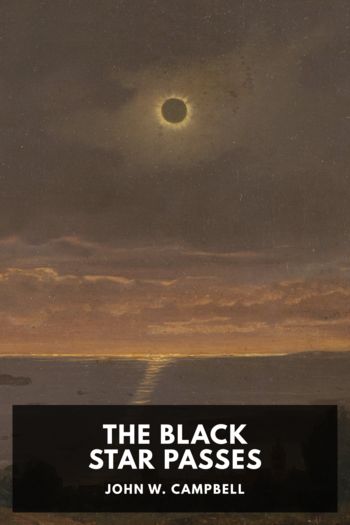Islands of Space - John W. Campbell (pdf to ebook reader TXT) 📗

- Author: John W. Campbell
Book online «Islands of Space - John W. Campbell (pdf to ebook reader TXT) 📗». Author John W. Campbell
“As a matter of fact, I was worried about that,” said Arcot. “Strong as that hull is, it might easily have been strained in that field of terrific force. If it happened to hit two ‘space waves’ at once, it might have given it an acceleration in two different directions at once, which would strain the walls with a force amounting to thousands of tons. I laid out the suits up front, and I think we might reasonably get out there and take a look at the old boat. When Wade gets up—well, well—speak of the devil! My, doesn’t he look energetic?”
Wade’s huge body was floating in through the library door. He was yawning sleepily and rubbing his eyes. It was evident he had not yet washed, and his growing beard, which was heavy and black on his cheeks, testified to his need for a shave. The others had shaved before coming into the library.
“Wade,” said Arcot, “we’re going outside, and we have to have someone in here to operate the airlock. Suppose you get to work on the hirsute adornment; there’s an atomic hydrogen cutting torch down in the lab you can use, if you wish. The rest of us are going outside.” Then Arcot’s voice became serious. “By the way, don’t try any little jokes like starting off with a little acceleration. I don’t think you would—you’ve got good sense—but I like to make certain. If you did, we’d be left behind, and you’d never find us in the vast immensity of intergalactic space.”
It wasn’t a pleasant idea to contemplate. Each of the suits had a radio for communication with each other and with the ship, but they would only carry a few hundred miles. A mere step in space!
Wade shook his head, grinning. “I have no desire to be left all by myself on this ship, thank you. You don’t need to worry.”
A few minutes later, Arcot, Morey, and Fuller stepped out of the airlock and set to work, using power flashlights to examine the outer hull for any signs of possible strain.
The flashlights, equipped as they were with storage coils for power, were actually powerful searchlights, but in the airlessness of space, the rays were absolutely invisible. They could only be seen when they hit the relux inner wall at such an angle that they were reflected directly into the observer’s eyes. The lux metal wall, being transparent, was naturally invisible, and the smooth relux, reflecting one hundred percent of the incident light, did not become illuminated, for illumination is the result of the scattering of light.
It was necessary to look closely and pass the beams over every square inch of the surface. However, a crack would be rough, and hence would scatter light and be even more readily visible than otherwise.
To their great relief, after an hour and a half of careful inspection, none of them had found any signs of a crack, and they went back into the ship to resume the voyage.
Again they hurled through space, the twin ghost ships following them closely. Hour after hour the ship went on. Now they had something else to do. They were at work calculating some problems that Arcot had suggested in connection with the velocities of motion that had been observed in the stars at the edge of the island universe they were approaching. Since these stars revolved about the mass of the entire galaxy, it was possible to calculate the mass of the entire universe by averaging the values from several stars. Their results were not exact, but they were reliable enough. They found the universe to have a mass of two hundred and fifty million suns, only a little less than the home Galaxy. It was an average-sized nebula.
Still the hours dragged as they came gradually nearer their goal—gradually, despite their speed of twenty-four light years per second!
At the end of the second day after their trouble with the cosmic ray field, they stopped for observation. They were now so near the Island Universe that the stars spread out in a huge disc ahead of them.
“About three hundred thousand light years distant, I should guess,” said Morey.
“We know our velocity fairly accurately,” said Wade. “Why can’t we calculate the distance between two of these stars and then go on in?”
“Good idea,” agreed Arcot. “Take the angle, will you, Morey? I’ll swing the ship.”
After taking their measurements, they advanced for one hour. Knowing this distance from experience, they were able to calculate the diameter of this galaxy. It turned out to be on the order of ninety thousand light years.
They were now much closer; they seemed, indeed, on the very edge of the giant universe. The thousands of stars flamed bright below them, stretching across their horizon more and more—a galaxy the eyes of men had never before seen at such close range! This galaxy had not yet condensed entirely to stars, and in its heart there still remained the vast gas cloud that would eventually be stars and planets. The vast misty cloud was plainly visible, glowing with a milky light like some vast frosted light bulb.
It was impossible to conceive the size of the thing; it looked only like some model, for they were still over a quarter of a million light years from it.
Morey looked up from his calculations. “I think we should be there in about three hours. Suppose we go at full speed for about two hours and then change to low speed?”
“You’re the astronomical boss, Morey,” said Arcot. “Let’s go!”
They swung the ship about once more and started again. As they drew nearer to this new universe, they began to feel more interest in the trip. Things were beginning to happen!
The ship plunged ahead at full speed for two hours. They could see nothing at that velocity except the two ghost ships that were their ever-present companions. Then they stopped once more.
About them, they saw





Comments (0)